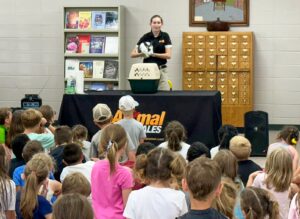Buds, blooms and Bradford Pears
Spring is literally slapping us in the face – and by literally, I mean you probably have been whacked by a limb or two while doing your seasonal pruning. Not only is it time for pruning, but blooms are leaping out from limbs all across north Alabama! Some of the most stunning displays are right in our front yards.
These beautiful trees might seem delightfully docile; however, one species holds a dark secret …
We observed National Invasive Species Awareness Week Feb. 25 through March 3 this year. During the week, we highlighted several invasive plant and animal species that are common in our area. One of the top emerging pests is none other than the snowy, white-blooming Bradford pear.
Yes, you read that right: Bradford pears are invasive. How, you might ask, can these pretty trees with a profusion of blooms be so bad? Well, let me tell you.
Bradford pears have been a favorite tree for homeowners and landscapers for years. They line driveways and fences. You even see them in parking lots on commercial properties. They have showy white flowers in early spring and bright reddish foliage in the fall. They grow quickly and provide excellent shade throughout our sweltering summers.
All of these factors make this tree a popular choice for most southern landscapes. However, the negative qualities of a Bradford pear far outweigh the positive.
First, I don’t know about you, but my opinion is that they stink! Have you ever walked by a row of Bradford pears in bloom? You might have thought you stumbled across an overflowing dumpster or that someone cleaned a fish nearby and left the carnage to bake in the sun. I’m probably exaggerating here, but Bradford pears do not have a pleasant odor.
From a structural standpoint, Bradford pears aren’t very stable. Their growth habit is such that their main branches come out from the trunk at very narrow angles. This trait, combined with weak wood, results in splitting during heavy winds or snow and ice events. This makes the Bradford pear a risk for any person, animal or object that is within striking distance of its branches.
Perhaps the most unsettling aspect of Bradford pears is the tendency they have to invade our cultivated and natural landscapes. To understand this, you might want a little history on these trees.
Bradford pears were originally cultivated to develop fire blight-resistant fruiting pear trees. The fruit from Bradford pears can often be sterile; however, they can sometimes cross-pollinate with other pears, which ends up producing non-sterile fruit. Birds and animals will take this fruit and spread it near and far.
I’m sure you’ve driven down the highway and seen white blooms waving at you from a stand of trees as you pass by.
Bradford pears have another issue. The top of the Bradford pear (scion) is grafted onto root stock of a pear from China that produces fertile fruit. This isn’t a problem until a Bradford pear is damaged back to the root stock – which, as we discussed earlier, happens in Bradford pears quite often. Once the scion is damaged, all the growth will come from the root stock. This growth will be vigorous and fertile and hard to control if not handled early on.
I hope this gives you some perspective on an unseemly beauty in our midst. Maybe you are considering taking a chainsaw to your Bradford pear this spring … You won’t see me shedding any tears. When you look to replace that tree, consider some of our native blooming trees instead. You can contact your local Extension agent for more information.
By Taylor Reeder
Regional Extension Agent
Home Grounds, Garden and Home Pests










